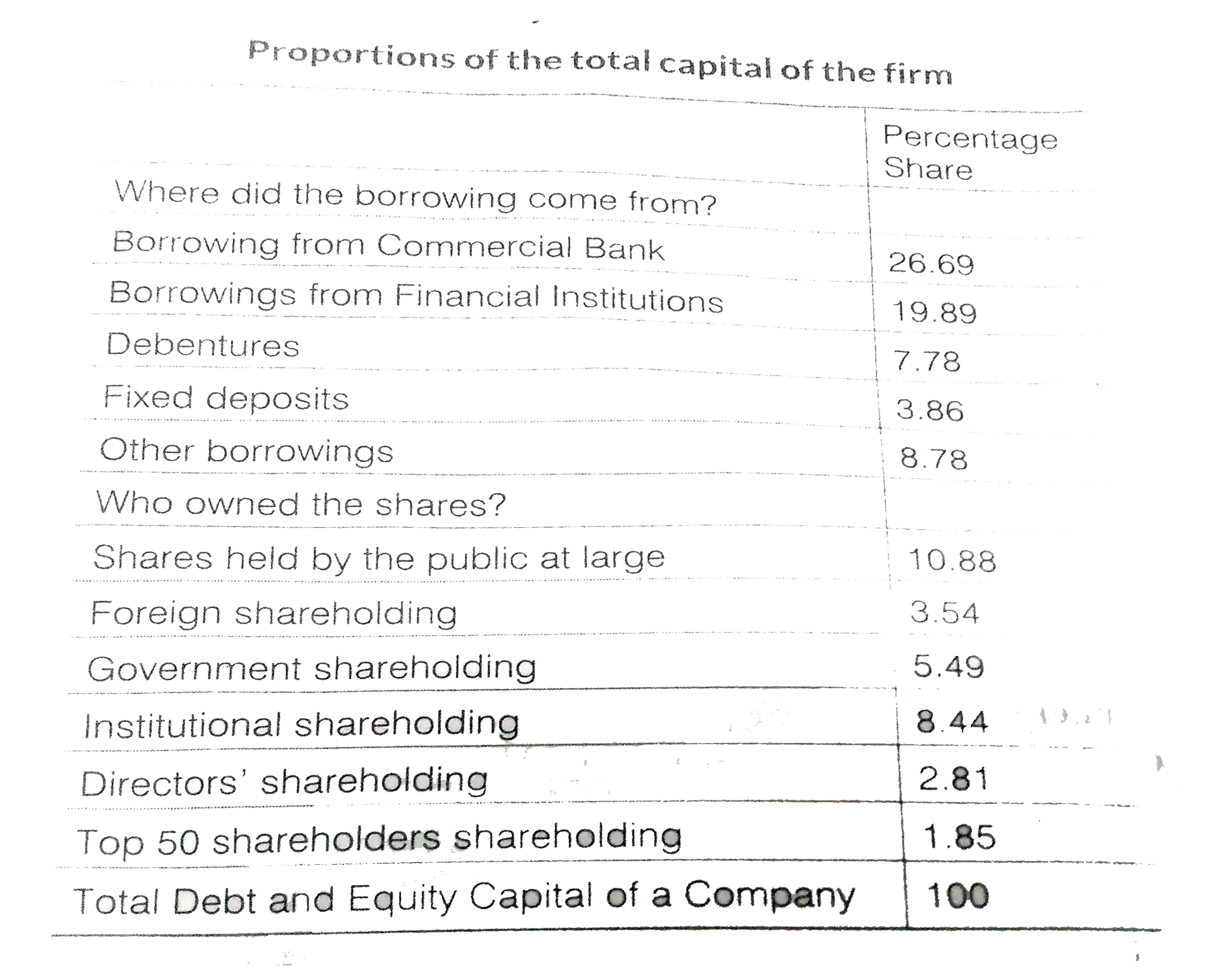Who funds Ildian Industry, Why it matters ?
Using data on listed lnidan firms from the mid-1980s to the 1990s, several issues relating to lndian indutry were investigated. One aspect then wast the extremely limited extent to which promoters and entrepreeneurs actually owned shares in the various compaines they had control of .

Nevertheless in spite of the relative lack of ownership, the majority of listed entities , mostly private sector companies , were managed by these founders, their successive family members and other promoters as if they were fiefdoms.
By and large, Indian companies were essentially financed by debt. This was unlike in the West. if the total debt plus nominal equity capital in the average. Indian company was 100, then 67 per cent of that amount came if the form of debt capital while equity capital contributed only 33 per cent.
if the share of govberment ownership in corporate equity and the share of financial instituions, equity was added, then over 60 per cent (26.69+ 19.89 + 5.49+ 8.44) of firms' finances were funded by the state in one form or another.
Foreign shareholder, in spite of a lot a clamour about their role in Inida's corporate economy, hardly owned more than 4 per cent ( 3.54) of the shares in Inida's listed compnaies. While the public at large probided about 11 per cent of th finaces of a average Inidan listed company, the sharte of the Top 50 shareholders was less than 2 ( 1.85) per cent. IT is within this particular shareholding category that promoters, entrepreneurs and the other large shareholder's equity stakes fall under for the purposes of classification.
The public at large provides five times as much money for the company as teh enrepreneurs. Yetm a group of induviduals, whose fiancial contributions towards a company are exceedingly small in magnitude, effectively control the company.
Which decision relates to the amount of debt and equity to finace the capital fo a company ?
Financing decsion This decsion relates to the relative proportion of various surces of finance such as shareholders funds and borrowed funds.
Topper's Solved these Questions
- Financial Management BOOK - ARIHANT PUBLICATIONCHAPTER - Financial Management EXERCISE - Self Assessment (mcQ)
4 Videos
- Financial Management BOOK - ARIHANT PUBLICATIONCHAPTER - Financial Management EXERCISE - Self Assessment (very short answer)
4 Videos
- Financial Management BOOK - ARIHANT PUBLICATIONCHAPTER - Financial Management EXERCISE - CHAPTER PRACTICE (Long Answer type )
18 Videos
- DIRECTINGBOOK - ARIHANT PUBLICATIONCHAPTER - DIRECTINGEXERCISE - CBSE Examinations Archive (LONG ANSWER TYPE)
12 Videos
- FINANCIAL MARKETBOOK - ARIHANT PUBLICATIONCHAPTER - FINANCIAL MARKETEXERCISE - CBSE Examinations Archive (Long Answer Type Questions)
6 Videos
Similar Questions
Which of the following is not an example of fixed capital decision ?
View SolutionHow does effective workng capital management increase efficincy ?
View SolutionExplain the term ' Financial management Breifly explain any two of its objectives.
View SolutionDescribe any three semantic barriers of communication.
View SolutionDifferentiate between 'Primary market' and 'secondary market' on any five basis.
View Solutionकिन्ही दो संयोजक कड़ी वाले जन्तुओ के नाम तथा वे किस संघ से संबंधित कड़ी है, बताइए!
View Solutionएक लम्बे तार में 10.0 ऐम्पियर की धारा उत्तर से दक्षिण की ओर प्रवाहित हो रही है। तार से 10.0 सेमी दूर एक इलेक्ट्रॉन को दक्षिण से उत्तर के ओर 2.0 मी/से की चाल से प्रक्षेपित किया गया है। इलेक्ट्रॉन पर लगने वाले चुम्बकीय बल का परिमाण एवं दिशा ज्ञात कीजिए।
View Solutionएक 5 हेनरी के प्रेरक में 0.1 सेकण्ड में धारा 12 ऐम्पियर से बदलकर 7 ऐम्पियर हो जाती है तो प्रेरक में कितना वि वा बल प्रेरित होगा ?
View Solutionएक कुण्डली का स्वप्रेरकत्व 3.0×10−3 हेनरी है |यदि 0.1 सेकण्ड में कुण्डली की धारा का मान 5 ऐम्पियर से घटकर शून्य हो जाये तो कुण्डली में उत्पन्न स्वप्रेरित विधुत वाहक बल की गणना कीजिए |
View Solutionएक कुण्डली का क्षेत्रफल 0.5मी2 तथा उसमें 50 फेरे है | कुण्डली के तल के लम्बवत 0.04 टेस्ला का चुम्बकीय क्षेत्र लगा है | यदि 0.1 सेकण्ड में चुम्बकीय क्षेत्र घटकर शून्य हो जाये तब कुण्डली में कितना प्रेरित विधुत वाहक बल तथा प्रेरित धारा होगी, यदि कुण्डली का प्रतिरोध 10 ओम हो ?
View Solutionएक प्रेरकत्व कुण्डली में वैधुत धारा 0.3 सेकण्ड में शून्य से बढ़कर 8.0 ऐम्पियर हो जाती है जिसके कारण उसमें 30 वोल्ट का प्रेरित विधुत वाहक बल उत्पन्न हो जाता है | कुण्डली का स्वप्रेरण गुणांक ज्ञात कीजिए |
View Solutionएक राजमार्ग पर दो बिन्दु A और B एक दूसरे से 90 किमी की दूरी पर है। एक कार A से तथा दूसरी कार B से एक साथ चलती हैं। यदि वे एक दिशा में चलती हैं, तो वे 9 घण्टे बाद मिलती हैं और वे विपरीत दिशा में चलती हैं, तो 97 घण्टे बाद मिलती है। उनकी चाल ज्ञात कीजिए।
View Solutionएक कक्षा के छात्रों को पंक्ति में खड़ा किया जाता है। यदि प्रत्येक पंक्ति में 4 अतिरिक्त छात्र होते तो 2 पंक्ति कम प्रत्येक पंक्ति में 4 छात्र कम होते तो 4 पंव्ति ज्यादा होती है। कक्षा में छात्रों की संख्या ज्ञात कीजिए।
View Solutionश्री मोहित ने एक निश्चित दूरी के लिए ट्रेडमिल पर चलने का फैसला किया है। पहले दिन, वह एक निश्चित गति से चलता है। अगले दिन, वह ट्रेडमिल की गति को 1 किमी/घंटा बढ़ाता है, वह 6 मिनट कम लेता है और यदि वह गति को 1 किमी/घंटा कम करता है, तो वह 9 मिनट अधिक लेता है। उसने प्रतिदिन कितनी दूरी चलने का निश्चय किया?
View Solutionएक परीक्षा में पास होने वाले तथा पेल होने वालो का अनुपात 3 : 1 था। यदि परीक्षा में 8 विद्यार्थी ज्यादा बैठते तथा 6 कम पास होते तो पास होने तथा फेल होने वालों का अनुपात 2 : 1 है। परीक्षा में कितने विद्याया बेठ थे?
View Solution40 बच्चों की एक कक्षा में लड़कियों और लड़कों का अनुपात 2 : 3 हैं। 5 नवे बच्चों ने कक्षा में प्रवेश लिया। इनमें किनने लड़के होने चाहिए जिससे लड़कियों और लड़कों का अनुपात 4 :5 हो जाए?
View Solution
